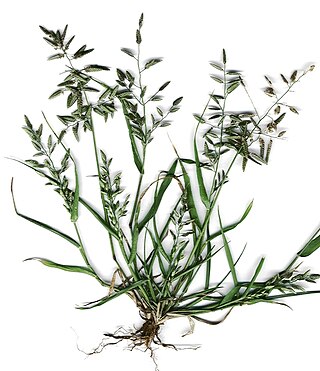
Eragrostis is a large and widespread genus of plants in the grass family, found in many countries on all inhabited continents and many islands.
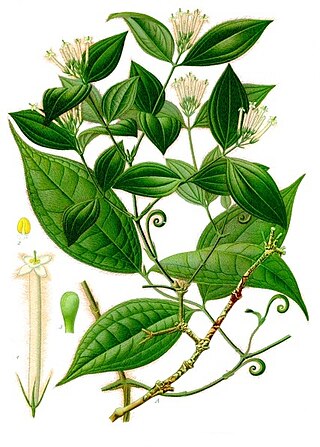
Strychnos is a genus of flowering plants, belonging to the family Loganiaceae. The genus includes about 200 accepted species of trees and lianas. The genus is widely distributed around the world's tropics and is noted for the presence of poisonous indole alkaloids in the roots, stems and leaves of various species. Among these alkaloids are the well-known and virulent poisons strychnine and curare.
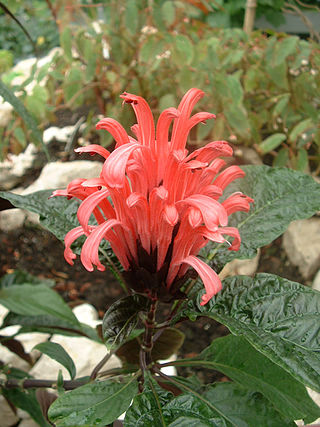
Justicia is a genus of flowering plants in the family Acanthaceae. It is the largest genus within the family, with over 900 accepted species. They are native to tropical to warm temperate regions of the Americas, India, and Africa. The genus serves as host to many butterfly species, such as Anartia fatima. Common names include water-willow and shrimp plant, the latter from the inflorescences, which resemble a shrimp in some species. The generic name honours Scottish horticulturist James Justice (1698–1763). They are closely related to Pachystachys.

Acanthus is a genus of about 30 species of flowering plants in the family Acanthaceae, native to tropical and warm temperate regions, with the highest species diversity in the Mediterranean Basin and Asia. This flowering plant is nectar-producing and depends on butterflies, such as Anartia fatima, and other nectar-feeding organisms to distribute its pollen. Common names include Acanthus and bear's breeches. The generic name derives from the Greek term ἄκανθος (akanthos) for Acanthus mollis, a plant that was commonly imitated in Corinthian capitals.

Anisacanthus is a genus of flowering plants in the bear's breeches family, Acanthaceae. The generic name is derived from the Greek words ανισος (anisos), meaning "unequal," and ακανθος (acanthos), meaning "thorn." Members of the genus are native to tropical and subtropical regions of the Americas. They are commonly known as desert honeysuckles, though this term is shared with the genus Ancistranthus, and is something of a misnomer as true honeysuckles belong to the family Caprifoliaceae. Anisacanthus species are sometimes cultivated for use in xeriscaping.

Gustav Lindau, was a German mycologist and botanist.

Chloroleucon is a genus of flowering plants in the family Fabaceae. It contains 11 species native to the tropical Americas, ranging from Mexico through Central America, the Caribbean, and South America to northern Argentina. Some authorities consider it part of the genus Albizia. Its name is derived from the Greek words χλωρóς (chloros), meaning "green," and λευκός (leukos), meaning "white."

Tephrosia is a genus of flowering plants in the family Fabaceae. It is widespread in both the Eastern and Western Hemisphere, where it is found in tropical and warm-temperate regions.
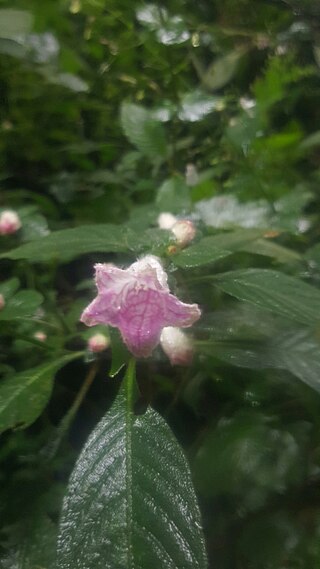
Acanthopale is a plant genus of shrubs or subshrubs in the Acanthaceae plant family. The genus name is based on the classic Greek words for thorn ákantha and stake palum. Some species in the genus are cultivated as ornamental plants.

Melinis is a genus of African and Arabian plants in the grass family.
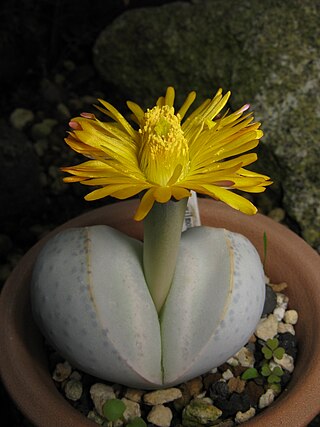
Dinteranthus is a genus of plants in the family Aizoaceae. It occurs in the arid northwestern parts of the Northern Cape Province, South Africa and the south-eastern parts of Namibia.
Dintera is a monotypic genus of flowering plants belonging to the family Plantaginaceae. It contains just one species, Dintera pterocaulisStapf, which comes from Namibia.
Englerocharis is a genus of flowering plants belonging to the family Brassicaceae.
Sclerotiaria is a monotypic genus of flowering plants belonging to the family Apiaceae. The only species is Sclerotiaria pentaceros. It is also in Tribe Coriandreae.
Sarcodraba is a genus of flowering plants belonging to the family Brassicaceae.











